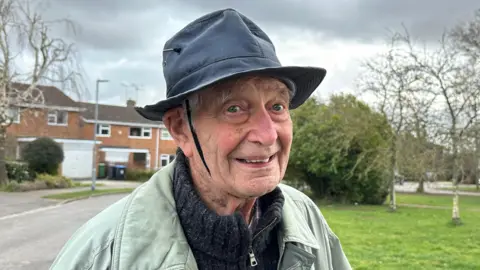Neve Gordon-Farleigh & Justin Dealey
BBC News, Hertfordshire

 Kian Boyle/BBC
Kian Boyle/BBC
Wayne Housden said even if he had not been able to keep the bird himself, he would have wanted to stay in contact
A Harris's hawk that terrorised a village for at least a month has found a forever home with a local falconer.
The bird of prey was blamed for dive-bombing attacks on about 50 people in Flamstead, Hertfordshire, including in one case where a man was taken to hospital.
Nicknamed "Bomber Harris", the hawk was eventually captured last month and has since been trained by falconer Wayne Housden.
He said the story had reached a happy ending, with the wayward bird having "calmed right down".

 Kimberley Piper/BBC
Kimberley Piper/BBC
Glyn Parry, 91, made a chinstrap out of a shoelace to avoid losing another hat
Hawk attacks man walking down road
At one stage there were discussions about the rogue bird having to be euthanised.
He was eventually handed to Mr Housden, who has worked with birds of prey for about 30 years.
The falconer revealed how his first priority was to stabilise his new feathered friend - and promptly spent about £1,000 building an aviary.
Mr Housden told the BBC he would take Bomber Harris to the popular Flamstead Scarecrow Festival in August.
He plans to keep the hawk full-time and hopes to be able to let him fly loose in the autumn - when he will hopefully come back again.

 Justin Dealey/BBC
Justin Dealey/BBC
Wayne Housden said he had spent about £1,000 building the Harris's hawk an aviary
Mr Housden said the hawk - a non-native South American species - was likely a captive-bred bird that had lost its falconer.
He said the dried-out leather tags on its feet suggested it had been loose for more than a year.
He had not been contacted by anyone claiming to be its owner, Mr Housden said.
"If I was to let someone else have him, I would have wanted to stay in contact with him," he added.
"He's been failed once and he is not going to be failed again."









 English (US) ·
English (US) ·